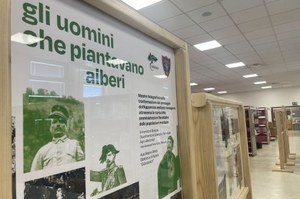An Exhibition at the University of Bologna on the Role of Forests in the Protection of the Emilia-Romagna Region

The exhibition realised by the Carabinieri Forestali (Italian Forest Police) is entitled “Gli uomini che piantavano gli alberi” and it will be inaugurated on Tuesday 5 March, at 12:15 p.m. in the Aula Magna at the Department of Agricultural and Food Sciences - DISTAL at the University of Bologna (Viale Fanin, 46 - Bologna).
The photo exhibition, hosted by the Department until 22 March, will highlight the efforts of the communities and forestry administrations. This work, which began in the 30s and continued until the 70s, aimed to achieve the common objective of expanding and safeguarding the forest heritage of Italy, particularly in Emilia-Romagna. It is an opportunity to reflect on the role of forests in the protection of the mountain territory, especially considering the recent exceptional events that have affected the Romagna region.
The exhibition will take the participants on a historical and anthropological journey, introduced by the Rector Giovanni Molari and DISTAL Head of Department Rosalba Lanciotti. Leading the way will be the speeches by the colonel Aldo Terzi, Commandant of the Group of Carabinieri Forestale of Bologna and Ferrara and curator of the exhibition alongside Pierangelo Bellettini, as well by Professors Federico Magnani from DISTAL and Gilmo Vianello from the Accademia Nazionale di Agricoltura.
“The exhibition was conceived in 2022, on the occasion of the bicentenary anniversary of the foundation of the State Forestry Corps and it was first set up in the Art and History Library of San Giorgio in Poggiale. The University of Bologna and DISTAL seemed to us a significant place to host it, both to offer stimuli to students who are building their professional lives, and in recognition of the role that the University of Bologna, Professor Umberto Bagnaresi and other colleagues have played in this field. The territory where our ancestors lived 70 to 100 years ago is clearly visible, but really different from today’s life conditions, relationships and attitude to work. The reconstruction done in those years is a real exploit, an extraordinary work. Mountains were often modified, and roads were built using only human strength, with few tools to support them” - says colonel Terzi. This is how art merges with history to become awareness. The displayed photos will show the interventions that “ensured a significant protection of the territory. An aspect of great topicality and interest today, considering the water crisis and flooding of last May. I believe this is a positive message showing that in the face of a changing climate, protection actions can still be planned.”
In recent years, the most damage caused by severe weather events have occurred mainly where reforestation happened naturally, due to the neglect of agriculture, without any planned assessment of water regulation. This is an operation that needs to become more important in the future. Bologna has played a crucial role, nationally, in forestry interventions. The association Pro montibus et silvis was founded and gave rise to the first national forestry congress in 1909, marking a turning point in the national forestry policy.
“The aim of this exhibition - says professor Magnani - is to emphasise the importance of memory, especially when dealing with the problem of how to manage ecosystems, particularly forests, in a sustainable way. It is not just a matter of historical curiosity, but of understanding the past to appreciate the present in order to plan for the future. There is an old rule among foresters: one must ask the forest, “who are you, where are you from, where are you going, how can I help you.” Only by understanding the origin of what is in front of us, can we plan for the future, following the path that the mountain is showing us, for the good of the ecosystems and the communities that inhabit them. An important school was established in our University with Professor Umberto Bagnaresi, who preceded me, and of whom colonel Terzi was a student. A school which has later sown the seeds in different forestry fields.”






